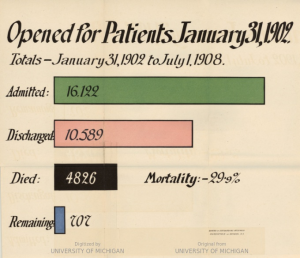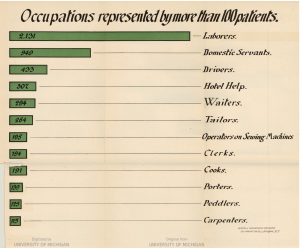Today we are pleased to feature five guest posts from students in Tom Ewing’s Virginia Tech Introduction to Data in Social Context class! The first is from Allyson Manhart, Andrew Pregnall, and Harshitha Narayanan.
 At the beginning of the twentieth century the Treasury Department of the United States classified pulmonary tuberculosis as a “dangerously contagious disease” which meant that any immigrant found to have tuberculosis coming to the United States would be denied entrance. The ban led to a swift reaction from the physicians of the New York Academy of Medicine, many of whom argued that the ban created unnecessary fear of those with tuberculosis.
At the beginning of the twentieth century the Treasury Department of the United States classified pulmonary tuberculosis as a “dangerously contagious disease” which meant that any immigrant found to have tuberculosis coming to the United States would be denied entrance. The ban led to a swift reaction from the physicians of the New York Academy of Medicine, many of whom argued that the ban created unnecessary fear of those with tuberculosis.
On January 2, 1902 the monthly meeting of the New York Academy of Medicine resulted in the Academy physicians proposing a resolution which rejected the Treasury Department’s new classification of pulmonary tuberculosis. The physicians felt their plans to establish a clinic for consumptives on Blackwell’s Island was threatened by the Treasury Department’s classification and the unnecessary fear they felt it created. Less than a month later on January 31, 1902, the Tuberculosis Clinic of the Metropolitan Hospital of New York opened its door to patients who needed public healthcare, both the curable and incurable (New York Times 1902).
The Tuberculosis Clinic of the Metropolitan Hospital of New York quickly became the central destination for consumptive patients in New York City as all consumptives in other charity hospitals were removed to the Metropolitan Hospital’s clinic. In the chart above, created by the director of the Metropolitan Hospital’s clinic, we can see the number of patients who were admitted or discharged, the number of patients who died, and the patients remaining in the clinic after a six year period.
While the mortality rate of almost one-in-three patients is high compared to other hospitals, it is important to remember that the Metropolitan Hospital’s clinic took in all patients from the New York City region — regardless of whether they could be cured or not. This raises a broader question: Who were the hospital’s patients?
The clinic took in 13,610 patients from 1902 to 1908. The graphic above shows the ethnic breakdown of the patients in the clinic versus the breakdown of the entire New York City population. People who were natives of the United States made up about 23% of the New York population and 42.8% of the patient population. The hospital reported that many of these patients were “born of foreign parents.” The second largest demographic group was the Irish, coming at 21.9% of the patient population. The surprising statistic was Germany’s representation. About 23% of the New York City population was German, but they only made up 8.2% of the clinic’s population. They are followed by Russia at 7.5%, Italy at 6%, Austria at 2.7%, and England at 2.5%. Ultimately, by looking at these statistics, it is easy to see that most of the consumption patients in New York City were first or second generation immigrants.
In addition to collecting information on the nationalities of their patients, the Tuberculosis Clinic of the Metropolitan Hospital of New York also collected data on their religions (65% were Roman Catholic and 25% were Protestant), sexes (about 80% male), age (65% were between the ages of 21 and 50), and occupations as seen in the graph above. The biggest takeaway from all of this data is that the patient population of the Tuberculosis Clinic of the Metropolitan Hospital of New York was comprised of poor first or second generation immigrants who likely worked long hours in poor paying, physically demanding service jobs, with less than ideal conditions, and then returned home to the tenement housing — characterized by poor sanitary conditions, overcrowding, malnutrition, etc — that was so prominent throughout urban centers of the United States at the time. These considerations explain to a large degree why these immigrants were so susceptible to tuberculosis.
Interestingly, the Tuberculosis Clinic of the Metropolitan Hospital of New York was very aware of the background of their patients and the effects they were having on the City of New York hospital system. In the words of the Clinic’s director:
The municipal hospital facilities of New York City have never yet been adequate to house in comfort all the sick poor seeking municipal aid. The main reason of this is the great influx of foreigners each year who never get any further into the United States than New York City. A glance at the nationality of the patients in Tuberculosis Infirmary will show this. [Emphasis added] (New York Times 1902)
Now that we understand who the Clinic’s patients were, one final question must be addressed: What social effects did tuberculosis have on these vulnerable first and second generation immigrant populations?
The simple answer is stigma. In an address to the New York Academy of Medicine on January 2nd 1902, Dr. Sigard Adolphus Knopf, an expert on pulmonary tuberculosis, said:
To my deep regret I learned recently that new difficulties have arisen concerning the site of our future New York State Sanitarium. Phthisiophobia, an exaggerated fear of the vicinity of consumptives, is the cause. What the people must learn is that consumption is not contagious, where the sputum is destroyed. It is hard to estimate how much hardship and suffering is incurred through the fear of consumption. It leads to real inhumanity. Useful citizens may be removed from their chances at success. [Emphasis added] (New York Times 1902)
He went on to say that the classification of pulmonary tuberculosis as a dangerously contagious disease, “plac[es] a stigma wholly undeserved upon every American citizen who is suffering with consumption,” and proposed a resolution, adopted by the Academy at their next meeting, which declared the exclusion of immigrants based on their consumptive status to be “unwise, inhumane, and contrary to the spirit of American justice.” (New York Times 1902)
Ultimately, the Tuberculosis Clinic of the Metropolitan Hospital of New York took in thousands of patients in the six year period, regardless of their curability. While we did not learn when the Tuberculosis Clinic closed from our research, there is still a hospital on those Blackwell Island grounds today (whether it was renamed or is part of a new organization, we are not sure). After analyzing the ethnic and occupational backgrounds of the patients, there is substantial evidence that the majority of the patients were poor first or second generation immigrants who likely worked jobs rife with occupational hazards and lived in unsanitary tenement housing. These occupational and domestic risk factors meant that these immigrants contracted tuberculosis at a substantially higher rate, and subsequently composed the majority of tuberculosis patients in New York City. Unfortunately, as Dr. Knopf explains, tuberculosis was a great source of fear in the early 20th century, and this fear was ultimately projected onto the immigrant populations most in need of public help.
Works Cited
Mills, Walter Sands. 1908. The Tuberculosis Infirmary of the Metropolitan Hospital, Department of Public Charities, New York City. New York: M. B. Brown Company. https//catalog.hathitrust.org/Record/002086417.
New York Times. 1902. “FEAR OF TUBERCULOSIS CALLED EXAGGERATED; Dr. Knopf Says It Leads to Real Inhumanity. Exclusion of Consumptive Immigrants Denounced at Academy of Medicine — Separate Hospital Advocated.,” January 3, 1902. http://query.nytimes.com/mem/archive-free/pdf?res=940CE0D81430E733A25750C0A9679C946397D6CF.







Pingback: Tuberculosis, Public Health, and Big Data – Medical Heritage Library